
The Oyster stitch is a member of the chain stitch family and although it looks complex, it is not difficult. Oyster stitch is also very versatile, as you can often adapt it to use in situations where you would use chain stitch. It creates a textured, slightly raised, stitch that is fun to work and adds variety to your hand embroidery. When worked in a line, Oyster stitch becomes Knotted Cable Chain stitch. You can also work a beaded variety. I wrote a tutorial on Beaded oyster stitch here.
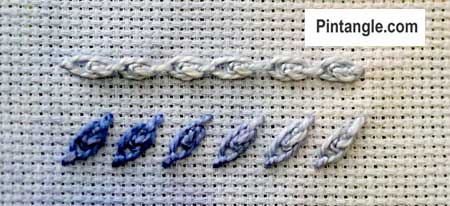
Step-by-step instructions on how to do Oyster Stitch
You start Oyster stitch with a twisted chain stitch.
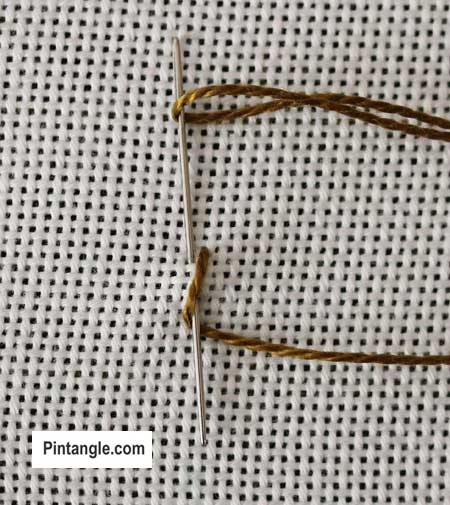
Commence, by bringing the thread to the front of the fabric, insert the needle, and take a bit of fabric with the tip pointed downwards. Wrap the needle as you would a twisted chain. In other words, cross the working thread over the needle, then wrap the thread under the needle.

Pull the needle through the fabric to create a twisted chain stitch. Pull your working thread snug, until the loop lies flat, but not so tight that it pulls on the fabric.
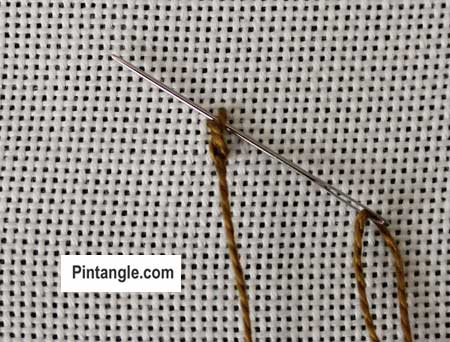
Pass the needle under the right-hand top thread above the loop that has formed. Slide the needle through without picking up the foundation fabric.
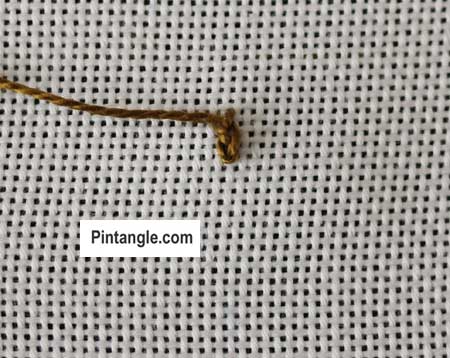
Pull the thread through.
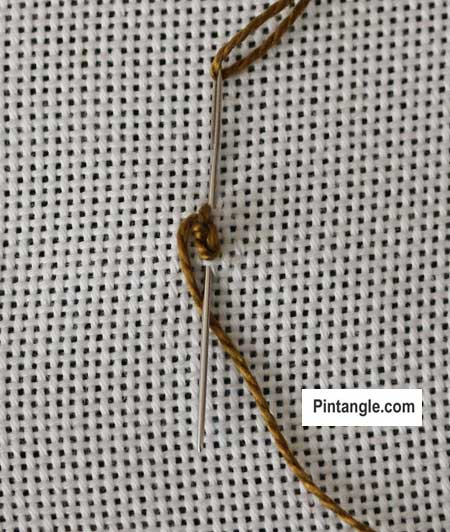
Insert the needle through the fabric at the top of the stitch, with the needle pointed downwards, slide it behind the knot so that the needle exits the cloth at the base as illustrated.
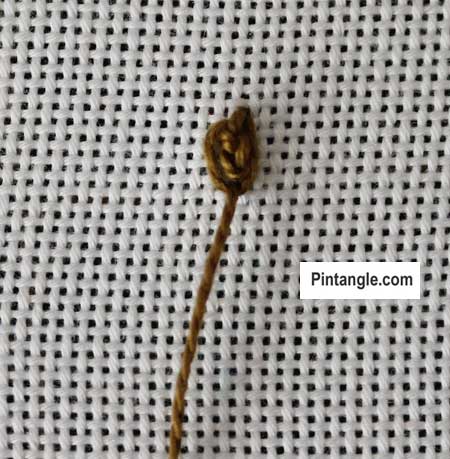
Loop the thread under the needle (as you would for a chain stitch) and pull the needle through. Tie it off by taking your thread to the back of the fabric, as you would a detached chain stitch.
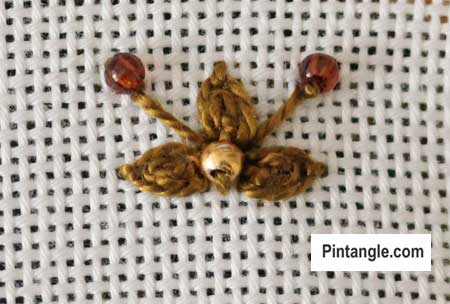
It can be used as buds in floral motifs or worked in a circle with the stitches pointing outwards to create flowers.
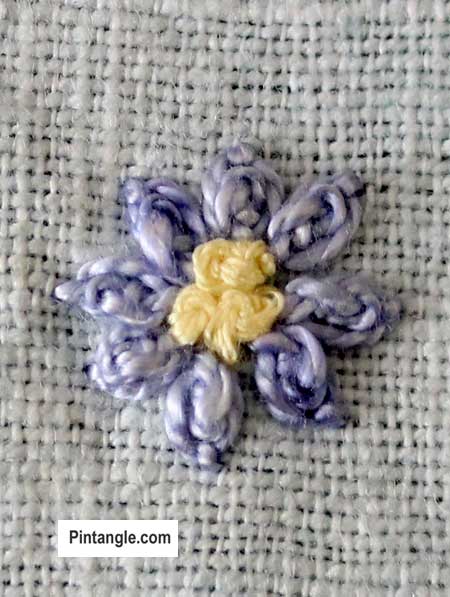
If you extend the last tie-off stitch that secures the chain, to a long straight stitch you have another variety.
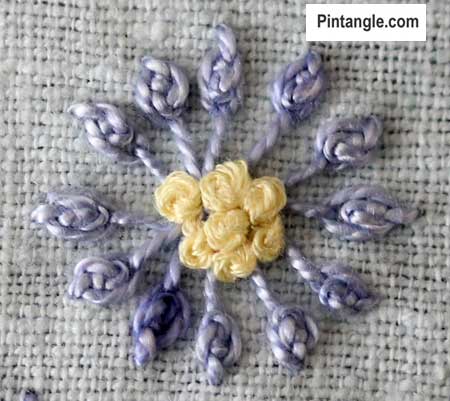
You can make these point toward the middle of the circle or outwards to create daisy and flower-like motifs.
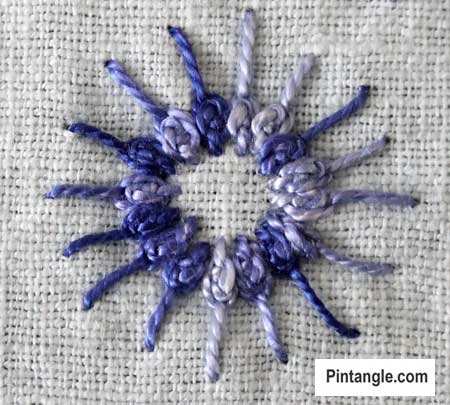
These samples were worked using a cotton perle #5 thread that is variegated.
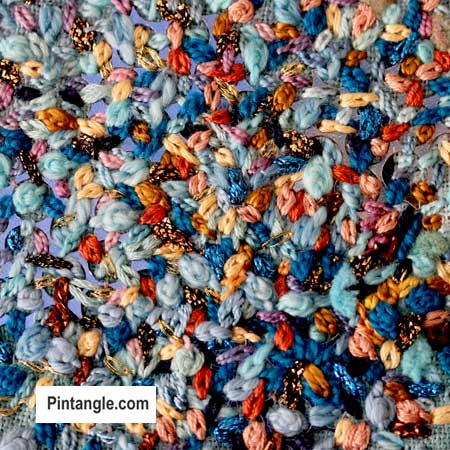
It has a highly textured appearance so sprinklings of this stitch in contemporary work produce a knobbly relief, particularly when worked in a thread with a good twist or a fine ribbon.
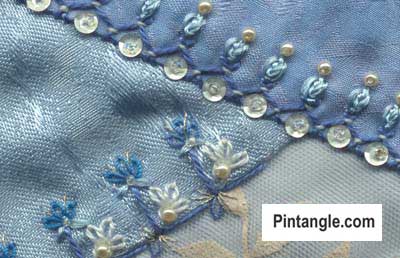
And of course, it is great for crazy quilting.

Here I worked the seam using a hand-dyed cotton thread that is the same thickness as perle #5 I worked Up and Down Buttonhole stitch. At the bottom of the ‘arms’ then worked Oyster stitch in rayon ribbon floss that was hand dyed. This crazy quilt seam detail comes from block 77 in the I Dropped the Button Box series. You can see that block here
I hope you enjoy the stitch!
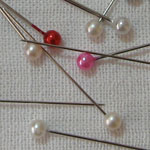 Follow Pintangle and have it delivered to your inbox
Follow Pintangle and have it delivered to your inbox
You can have Pintangle delivered to your inbox by using the subscribe feature in the sidebar. Enter your email address, and when you get the confirmation email make sure you respond to be all set!
If you are on a mobile or tablet scroll to the bottom to find the subscribe feature.
Thread Twisties!
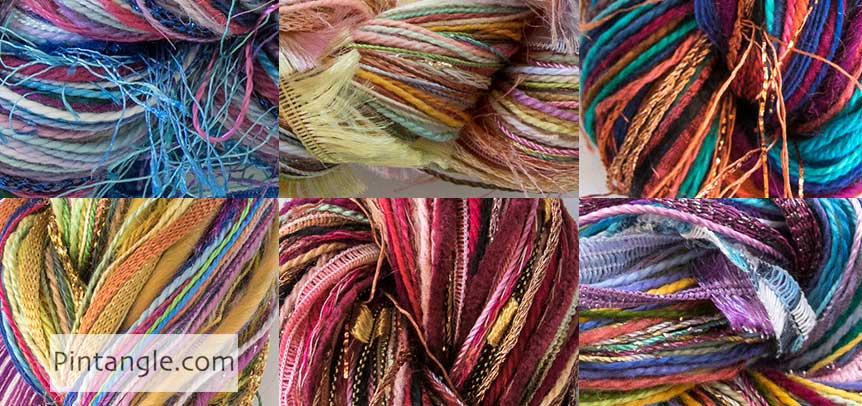
Experimenting with different threads can be expensive. You would normally have to buy a whole skein of each type of thread. My thread twisties are a combination of different threads to use in creative hand embroidery. These enable you to try out stitching with something other than stranded cotton. For the price of just a few skeins, you can experiment with a bundle of threads of luscious colours and many different textures.
These are creative embroiders threads. With them, I hope to encourage you to experiment. Each Twistie is a thread bundle containing silk, cotton, rayon and wool. Threads range from extra fine (the same thickness as 1 strand of embroidery floss) to chunky couchable textured yarns. All threads have a soft and manageable drape. Twisting them around a needle makes experimental hand embroidery an interesting journey rather than a battle. Many are hand dyed by me. All are threads I use. You may find a similar thread twist but no two are identical.
You will find my thread twisties in the Pintangle shop here.



Sharon is this tutorial upside down I love the oyster stitch
Thankyou
Hi Denny No the tutorial is not upside down – why do you ask?
I come in brom the bottom I need to practice your way ,thankyou si much
This was a great stitch to learn. Thankyou.
My trials are posted here.
http://hobbysewing.blogspot.com/2020/09/tast-19-beyond-tast-19.html
Sharon. That looks a really useful stitch – very many thanks. Hope all is well at your end.
Best wishes
Andy LW
HI Andy I hope you and yours are well too – take care
2018 TAST Stitch #39: https://www.thecrafties.com/2018/12/tast-roundup-3/
I need to play with this one more – I can see a lot of options with designs and borders!
-C
Used the oyster stitch for sunflowers on a fall project: https://chasehandcraft.com/2018/11/10/oyster-stitch-tast-39/
Sharon, I don’t believe you’ve ever met a stitch that was not “quick and easy to do.” I don’t think I would have known about oyster stitch without TAST. Thanks.
JOWynn you make me laugh -I sort of have my favourites and I guess I share them most but I do have moments where I think “this stitch is annoying or frustrating”
I agree with you..I too have never known this..Thanks to TAST, I am enjoying the new stitches introduced weekly.
The oyster stitch is so pretty. There are so many things to create with it. I will set down and try it today. I imagine it will look more impressive with a good thickness of thread. You open up so many creative juices with your tutorials. Thank you. patty
HiPatty pleased it has got the creative juices going!
Finally finished with my July Stitches. Take a look at
http://sparemomentstitching.wordpress.com/2012/10/03/july-tast-and-cqjp-in-september/
voici mon point de cette semaine
Here’s my complete failure with the oyster stitch:
http://harvestmoonbyhand.blogspot.com/2012/07/take-stitch-tuesday-oyster-stitch-week.html
Even though others had success and can do the stitch beautifully, mine look rather pathetic.
So, if there’s anyone who struggled with this stitch…you’re not alone. Take comfort in your work by looking at my examples.
The oyster stitch is difficult, I’ve found myself having to cut the thread after doing a knot with it, but it is still beautiful
This time I have two weeks in one so I could catch up more easily, but I’m still one week behind.
http://fanaticalseamstress.wordpress.com/2012/08/02/punto-vasco-y-punto-ostra/
Here is my Oyster stitch sample.
http://eclecticlamb.com/2012/08/02/week-30-oyster-stitch/
I’ve finally posted on my blog about trying Oyster stitch. I’ve been a bit lax about leaving comments on here about my blog recently because I’ve been so busy and everything’s been done in a rush. I’ve been just about keeping up with the stitches, as long as I keep them simple. http://kirajones.co.uk/?p=835
I stitched a swirl on one of my samplers and I used it on a project I’m working on:
http://fat-quarter.blogspot.nl/2012/07/oyster-stitch.html
Just in time for the next stitch!
This was a great stitch to do. So much texture. My sample is on my blog here: http://dinkydideequilts.blogspot.com.au/2012/07/oyster-stitch.html
I finally got the hang of this stitch. It wasn’t easy but once I figured it out I was good to go. Blogged about my experience here with my step by step photos for lefties.
http://therosejournal.blogspot.com/2012/07/for-lefties.html
Blogged here: http://airynothing.net/Blogs/anblog/2012/07/29/tast-oyster-stitch-catch-up
I stitched the Oyster stitch on my Crazy Quilt block for July (CQJP) and also variations of the stitch on my Stitch Journal page. All can be seen at the following link.
http://free-form-stitching.blogspot.co.nz/2012/07/tast-oyster-stitch-crazy-quilt-project.html
Thank you Sharon for introducing me to another stitch that I have not tried before.
I finally did my oyster stitch sample.
You can find it here:
http://cantheleopardchangeherspots.blogspot.com/
here is my oyster stitch sampler..
http://leelashobbies.blogspot.in/2012/07/tast-2012-week-30-oyster-stitch.html
http://www.flickr.com/photos/49761407@N04/7668752372/in/photostream/
Am I the last to post? It’s been a busy week, but here is the Oyster stitch:
http://queeniepatch.blogspot.se/2012/07/tast-2012-week-30.html
http://stitchinfingers.ning.com/photo/tast2012-week-30
This is what I managed to do this week: http://www.flickr.com/photos/airycat/7666550994/in/set-72157625935962920/
I think the oyster stitch is quite delightful
http://playfulstitching.wordpress.com
I got lucky with the Oyster stitch as I combined it with the Basque stitch in one seam and am now caught up again. You can see the stitches here http://www.flickr.com/photos/susie_w/with/7664606420/#photo_7664606420 .
Hi Sharon and fellow Tasters!
this was a wonderful stitch – I worked it with some bullions too! here is my newbie working of the stitches:
http://kippyssomature.blogspot.com/2012/07/oyster-30.html
thank you!
hello,
the pearl stitch was very funy to learn. You can find the work of my daughter and mine here :
http://pierrespapiersciseaux.blogspot.fr/2012/07/tast-30-le-point-de-perle.html
makes a cute little flower
http://temaribarb.blogspot.com/2012/07/week-30-of-take-stitch-tuesday-my-how.html
My sample of the interesting oyster stitch is here:
http://www.flickr.com/photos/stitchinwoman/7663312518/in/photostream
Sharon
Here is the link for this weeks challenge
http://www.shamiatcraft.blogspot.in/2012/07/tast-2012-week-30-oyster-stitch.html
Hi Sharon,
this is an interesting stitch. I missed it during your previous challenge. I have started on this sampler, the details are here-
http://jizee6687.wordpress.com/category/tast-2012/30-oyster-stitch/
Thank you,
Chitra
Nice stitch, not sure about my samples though.
http://linsartyblobs.blogspot.co.uk/2012/07/tast-30.html
here is my oyster sitch sampler :
http://dufall.blogspot.fr/
I enjoy very much this stitch Thanks Sharon
Got mine done……………. Not a bad stitch at all to do..Kind of fun actually!
Here is my trials on oyster stitch.
This is the first time I tried.
http://withbrushandneedle.blogspot.in/2012/07/tast12-week-30-oyster-stitch.html
-preethi.
It is an intersting stitch.
I triedit out with fly, feather,upanddownbuttonhole and whipped stitches.
Soon will do one project with this stitch alone.
It is http://viji-crafts.blogspot.in/2012/07/tast-2012-week-30.html
Hi Sharon,
My sampler of Oyster Stitch is in my blog
http://www.sadalas.blogspot.in/2012/07/tas-t2012-week-30-oyster-stitch.html
Hi Sharon & Friends
My post for the week. Thank you all
http://stitchinfingers.ning.com/photo/golden-faith?context=user
or
http://embroiderland.blogspot.com.br/
Hi Sharon,
Made it a day earlier this week,
I blogged about it here:
http://www.carorose.typepad.com
and added it to the Flickr pool;
http://www.flickr.com/photos/carorose/7654785352/in/pool-56846286@N00
Cheers
Carolyn
Sorry, I forgot to post the link to my block:
http://stitchinfingers.ning.com/photo/oysterstitch plus some detail pictures.
My results for week 22 to 30 are uploaded. I really got the kick out of oyster stitch which was new to me like bonnet stitch and basque stitch. Great to get to know them!
My miniature floral sample
Here
https://pintangle.com/stitchers-worksheets/
Barbara
My sampler stitch for TAST week 30 – Oyster stitch.
http://latha-mycreations.blogspot.com/2012/07/tast-week-30-oyster-stitch.html
here is my post tast week 30 oyster stitch http://nalinihandwork.blogspot.in/2012/07/hand-embroidery-oyster-stitch.html
A new stitch for me. Nice for a flower.
http://6stem5.canalblog.com
Slowly but steadily. Here are my samplers 24&25:
Buttonhole Wheel
http://thriftyfinn.wordpress.com/2012/07/25/tast-24-buttonhole-wheel/
Cable Chain Stitch
http://thriftyfinn.wordpress.com/2012/07/26/tast-25-cable-chain-stitch/
Now if you’ll excuse me, I’m going to skip eat&sleep to stitch.
voici mon oyster stitch de la semaine.
http://carrementcrazy2.canalblog.com/archives/2012/07/26/24780454.html.
Sharon – I love the oyster stitch (like all knotted stitches). It reminds me of when I used to make my mother macrame plant hangers when I was young. Here’s my example: http://stitchinfingers.ning.com/photo/tast-oyster-stitch?context=user
My oyster stitch is here…
http://thatyankstitches.multiply.com/journal/item/341/Take-A-Stitch-Tuesday-2012-Challenge-Week-30
I found it a little “fiddly” regarding tension and, as in some of the previous complex stitches, kept losing my place.
Needless to say the stitch was new to me and again I must say I like the Oyster stitch maybe for giving structure: Thanks, Sharon for this wonderful possibility to learn! Here is my exercise: http://fabricfusion.blogspot.co.at/2012/07/tast-week-30-oyster-stitch.html
so nice stitch! this is my first attempt
http://alovchany.blogspot.com/2012/07/tast-week-30-oyster-stitch.html
This is a new sitch for me; http://stitchinfingers.ning.com/photo/oyster?context=album&albumId=2105845%3AAlbum%3A358782
This was a new stitch for me using, although I knew of it. But I tried it, and liked it! It can be found at http://karrinscrazyworld.blogspot.com/
My TAST stitching for this week: http://debbiesfiberwork.blogspot.co.il/2012/07/tast-week-30-knitter-winner.html which includes a photo of a full view of my TAST sampler so far.
Catching up TAST weeks
http://latha-mycreations.blogspot.com/2012/07/catching-up-tast-2012.html
Hi Sharon, once again you have given me inspiration and knowledge………A beautiful stitch, when you mastered it !
I was pulling the tension too tight to begin with but Ahhhh,
once I had realised this……..the world was my oyster !!
Thank you dear Sharon, you can see my sample here…….
http://ellascraftcreations.blogspot.co.uk/2012/07/tast-2012-week-30-oyster-stitch.html
hugs
Chris richards
xxxxxxxxxxx
Hi Sharon, you can see my “delicious peas” here :
http://homemadebyme.tumblr.com/post/27978168467/tast-2012-week-30-oyster-stitch-point-de
This is a new stitch for me . I like it and will try to use it again. I did not find it difficult to learn so that was good! http://princessbubblescreates.blogspot.ca/
Here’s my weekly post with old oyster stitches:
http://fat-quarter.blogspot.nl/2012/07/old-oyster-stitches.html
This time it was difficult to find visible samples of the oyster stitch!
Dear Sharon,
I caught up with my TAST-piece this morning. I may have found my Nemesis: Basque stitch. I just couldn’t get the tension right. I did like bonnet stitch as it produces nice outlines. Oyster stitch was ok, but a bit too messy to my taste. I can see this stitch being very effective as a flower bud, though. My favourite was clearly the up and down buttonhole stitch. It is sure to become a stitch I will use more and more in my stitching.
Have a nice day, Jessica